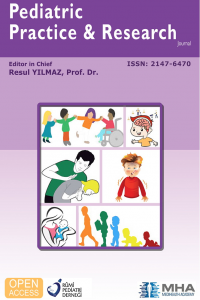GEBELİK İNTRAHEPATİK KOLESTAZ OLGULARININ MATERNAL VE NEONATAL SONUÇLARI
İntrahepatik Kolestaz, Gebelik, Yenidoğan sonuçları, Safra asidi, Ölü Doğum
THE OUTCOME OF MATERNAL AND FETAL CASES WITH INTRAHEPATIC CHOLESTASIS OF PREGNANCY
Intrahepatic Cholestasis, Pregnancy, Neonatal outcomes, Bile acid, Stillbirth,
___
- 1.Clinical Updates in Women's Health Care Sum- mary: Liver Disease: Reproductive Considerations. Obstet Gynecol 2017; 129: 236.
- 2.Chen Y, Vasilenko A, Song X, et al. Estrogen and estrogen receptor-α-mediated transrepression of bile salt export pump. Mol Endocrinol. 2015;29: 613–626.
- 3. Manzotti C, Casazza G, Stimac T, et al. Total serum bile acids or serum bile acid profile, or both, for the diagnosis of intrahepatic cholestasis of pregnancy. Cochrane Database Syst Rev. 2019 Jul 05;7:1-90.
- 4. Ovadia C, Seed PT, Sklavounos A, et al. Association of adverse perinatal outcomes of intrahepatic cholestasis of pregnancy with biochemical markers: results of aggregate and individual patient data meta-analyses. Lancet. 2019;393:899–909.
- 5. Bicocca MJ, Sperling JD, Chauhan SP. Intrahepatic cholestasis of pregnancy: a review of six national and regional guidelines. Eur J Obstet Gynecol. 2018;231:180–187
- 6. Abu-Hayyeh S, Papacleovoulou G, Lövgren-Sand- blom A, et al. Intrahepatic cholestasis of pregnancy levels of sulfated progesterone metabolites inhibit farnesoid X receptor resulting in a cholestatic phenotype. Hepatology. 2013;57:716–726.
- 7. Marschall HU, Wikström Shemer E, Ludvigsson JF, et al. Intrahepatic cholestasis of pregnancy and associated hepatobiliary disease: a population-based cohort study. Hepatology. 2013:58;1385-1391.
- 8. Williamson C, Miragoli M, Sheikh Abdul Kadir S, et al. Bile acid signaling in fetal tissues: Implications for intrahepatic cholestasis of preg- nancy. Dig Dis.2011;29:58–61.
- 9. Williamson C, Geenes V. Intrahepatic cholestasis of pregnancy. Obstet Gynecol. 2014;124:120–133.
- 10. Geenes V, Williamson C. Intrahepatic cholestasis of pregnancy. World J Gastroenterol. 2009;15: 2049–2066.
- 11. Glantz A, Marschall HU, Mattsson LÅ. Intrahepatic cholestasis of pregnancy: relationships between bile acid levels and fetal complication rates. Hepatology. 2004;40:467–474 .
- 12. Kong X, Kong Y, Zhang F, et al. Evaluating the effectiveness and safety of ursodeoxycholic acid intreatment of intrahepatic cholestasis of pregnancy: a meta-analysis [a prisma-compliant study]. Med [United States]. 2016;95:40-49.
- 13. Kondrackiene J, Beuers U, Kupcinskas L: Efficacy and safety of ursodeoxycholic acid versus cholestyramine in intrahepatic cholestasis of pregnancy. Gastroenterology. 2005, 129:894-901. 10.1053/j.gastro.2005.06.019.
- 14. Bacq Y, Sentilhes L, Reyes HB, et al. Efficacy of ursodeoxycholic acid in treating intrahepatic cholestasis of pregnancy: a meta-analysis. Gastroenterology. 2012;143:1492–1501.
- 15. Gurung V, Stokes M, Middleton P, et al. Interventions for treating cholestasis in pregnancy. The Cochrane Database of Systematic Reviews, 2013; 2013[6]:CD000493.
- 16. Grand’Maison S, Durand M, Mahone M. The effects of ursodeoxycholic acid treatment for intrahepatic cholestasis of pregnancy on maternal and fetal outcomes: a meta-analysis including non-randomized studies. J Obstet Gynaecol Canada. 2014;36:632–641.
- 17. Hanns-Ulrich Marschall 1, Elisabeth Wikström Shemer, et al. Intrahepatic cholestasis of pregnancy and associated hepatobiliary disease: a population-based cohort study Affiliations expand Hepatology 2013 Oct;58[4]:1385-91. doi: 10.1002/hep.26444.
- 18. Snape WJ, Shiff S, Cohen S. Effect of deoxycholic acid on colonic motility in the rabbit. Am J Physiol Liver Physiol. 1980;1:321–325.
- 19. McPherson C, Inder T. Perinatal and neonatal use of sedation and analgesia. Semin Fetal Neonatal Med. 2017;22[5]:314-320.
- 20. Palma J, Reyes H, Ribalta J, et al. Effects of ursodeoxycholic acid in patients with intrahepatic cholestasis of pregnancy. Hepatology. 1992;15: 1043–1047.
- 21. Chappell LC, Bell JL, Smith A, et al. Ursodeoxycholic acid versus placebo in women with intrahepatic cholestasis of pregnancy [PITCHES]: randomized controlled trial. Lancet. 2019; 394:849–860.
- 22. Puljic A, Kim E, Page J, et al. The risk of infant and fetal death by each additional week of expectant management in intrahepatic cholestasis of pregnancy by gestational age. Am J Obstet Gynecol. 2015; 212:667. e1–667.e5.
- 23. Gantt AB., Miller RS. ACOG Committee Opinion. Medically indicated late-preterm and early-term deliveries. Obstet Gynecol. 2021;138: e35-e39.
- ISSN: 2147-6470
- Başlangıç: 2013
- Yayıncı: MediHealth Academy Yayıncılık
GEBELİK İNTRAHEPATİK KOLESTAZ OLGULARININ MATERNAL VE NEONATAL SONUÇLARI
Züat ACAR, Yunus ÇAVUŞ, Yusuf BAŞKIRAN
Özlem AKARSU, Mahmut Caner US, Remziye SEMERCİ, Özge BAYRAK, Dilan DAMAR, Dilay MECİHAN
YouTube Videolarının İshalli Bebek Annelerinde Emzirme Eğitimine Etkisi
Ebeveynlik Stilleri ve Fiziksel Ceza Kullanımı: Bağıntılar Üzerine Bir Araştırma
Nicel YILDIZ SİLAHLI, Şenay TÜRE
Meltem GÜMÜŞ, Alaaddin YORULMAZ, Reyhan GÜMÜŞTEKİN, Anna Carina ERGANİ, Serdar UĞRAŞ, Halil Haldun EMİROĞLU
Yılmaz KOÇAK, Nesrin CEYLAN, Maşallah ERMAYA, Halit DEMİR, Yıldıray BASBUGAN
Üriner Sistem Taşı Olan Çocuklarda Obezitenin Metabolik Risk Faktörlerine Etkisi
Sevgin TANER, Kamina PANAHLI, Asena ÜNAL, Gunay EKBERLİ, Orkun TOLUNAY
Fatma ÖZGÜÇ ÇÖMLEK, Beyhan ÖZKAYA DÖNMEZ, Hümeyra YAŞAR KÖSTEK, Emine DİLEK, Diğdem BEZEN, Filiz TÜTÜNCÜLER
Çocuklarda Anafilaktik Reaksiyonların Özellikleri: Çocuk Alerji Kliniği Bulguları
Fatih ÇİÇEK, Ugur ALTAS, Zeynep Meva ALTAŞ, Ayşen ÇETEMEN, Mehmet Yaşar ÖZKARS
Çocuklarda Obezite ve Psikolojik Sağlamlık; Bağlantının Araştırılması
